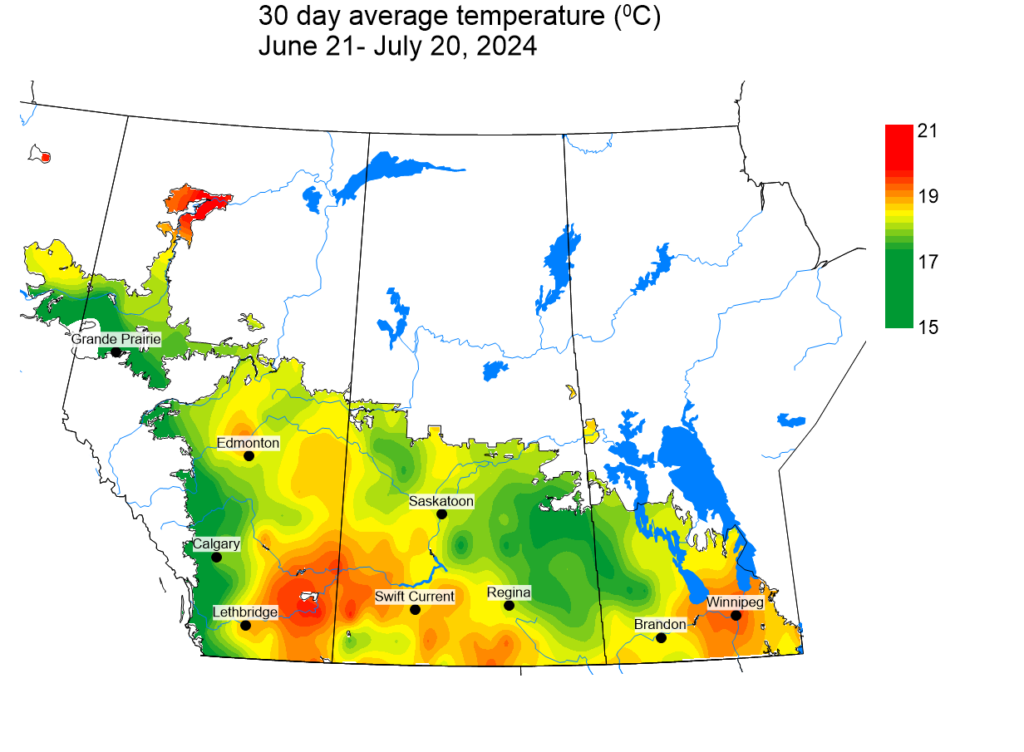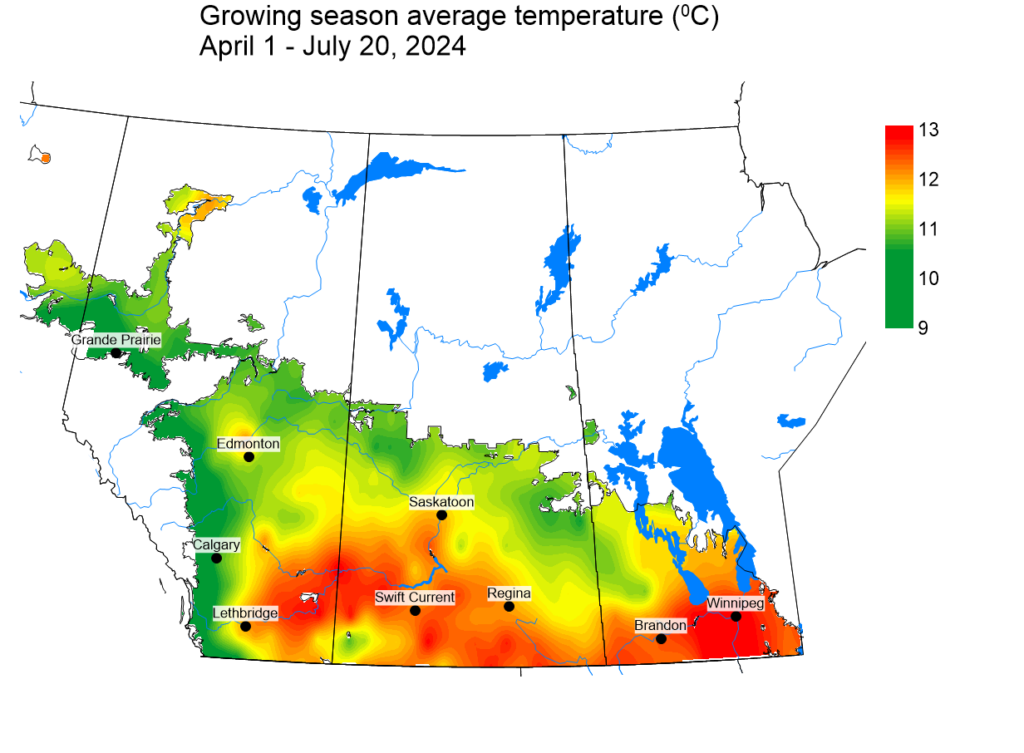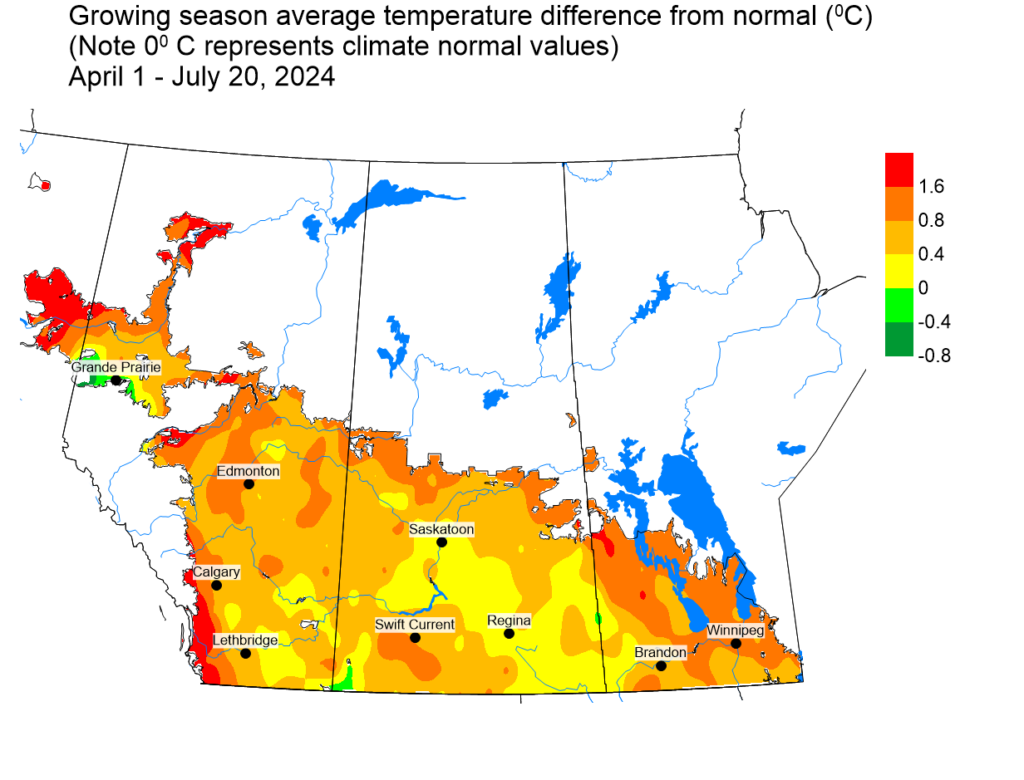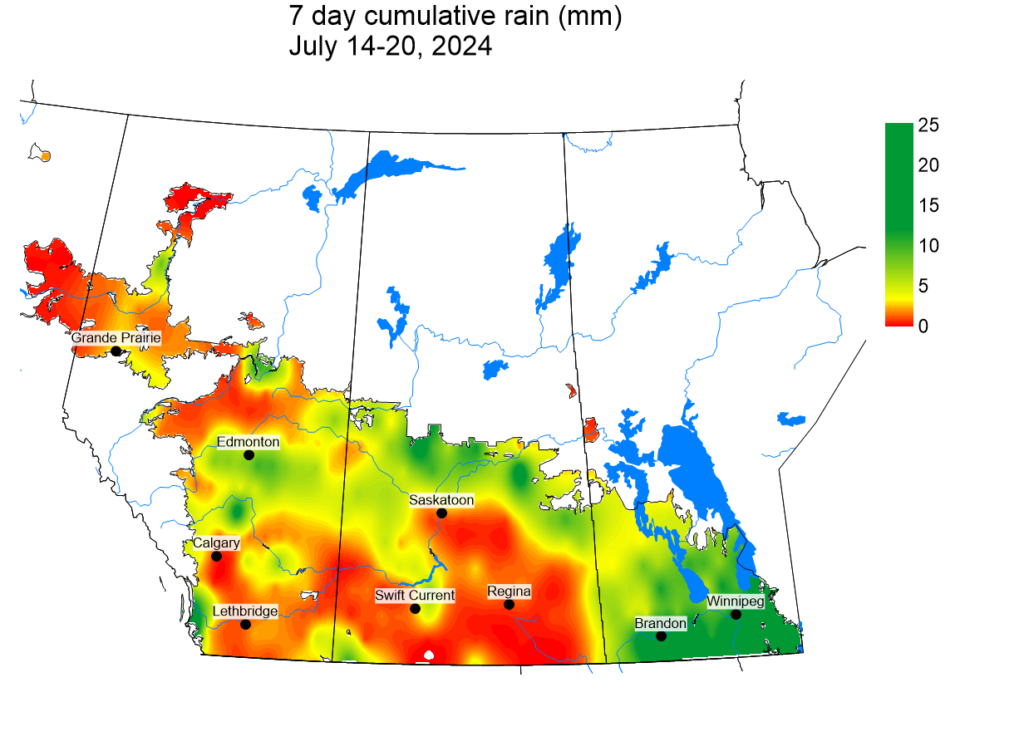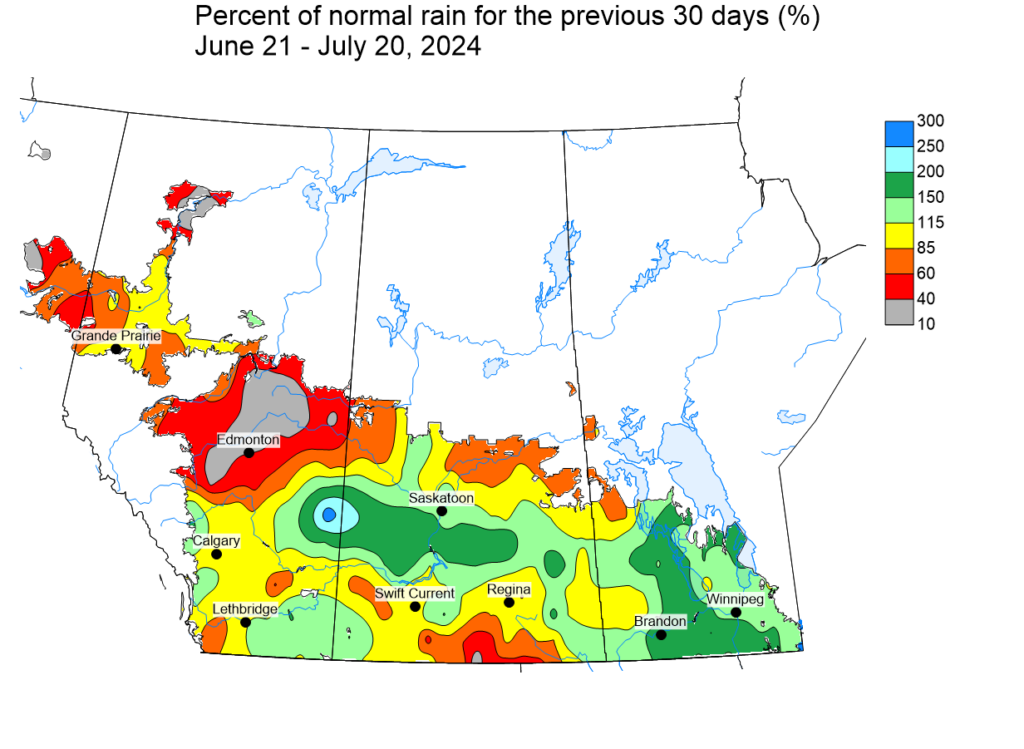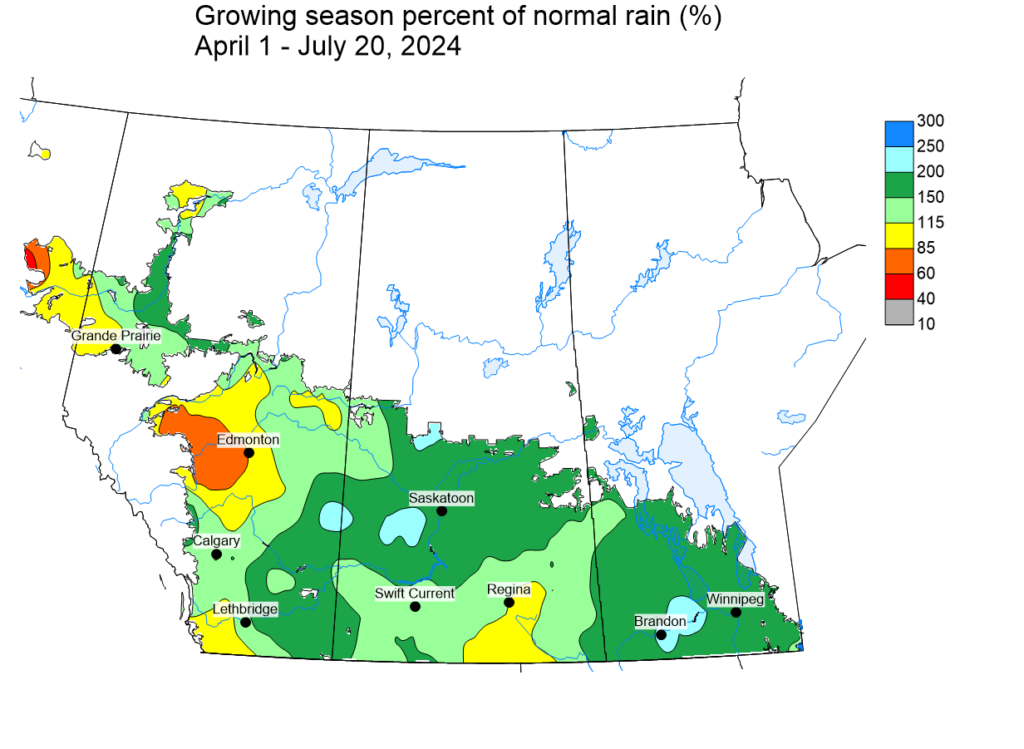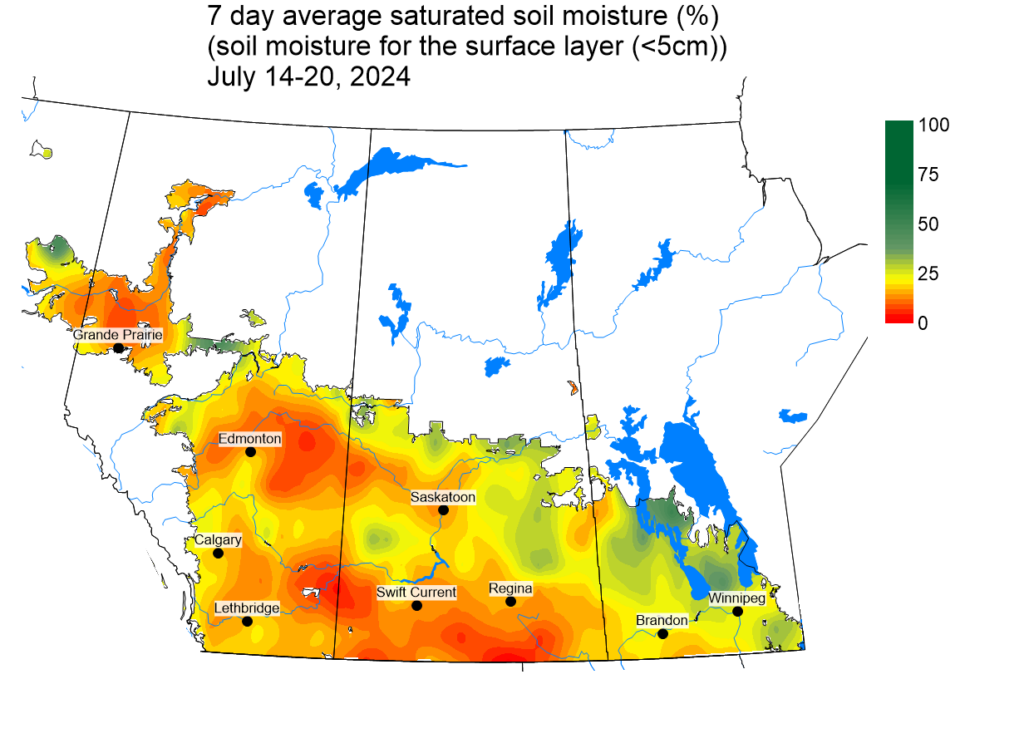This is the fifth weekly PCDMN soil moisture update in relation to the risk of sclerotinia sclerotial germination and potential risk of stem rot of canola. For details on the background of these updates please visit the first, second, third, and fourth weekly updates for 2024 for background on the maps and information on sclerotinia risk assessment.
Relative to climate normal values, average temperatures have increased over the past four weeks. The 7 day average temperature for July 14-20, 2024 was 20.5°C and was 3.3°C warmer than normal. Warmest temperatures were observed for northern regions of the Alberta Peace River region, eastern regions of Alberta, and southern regions of Saskatchewan (Figure 1). The 30 day (June 21-July 20) average temperature (18.4°C) was 2°C warmer than average (Figure 2). Growing season (April 1 – July 20) average temperatures have been 0.7°C warmer than average (Figures 3 and 4).
Last week (July 14-20, 2024) average cumulative 7 day rainfall was 4.4 mm (Figure 5). Most of the prairies have reported 30 day rainfall amounts that were normal to above normal (Figure 6). Rainfall amounts have been above normal for the majority of Manitoba and normal to below normal for most of Alberta. Driest conditions were observed near Edmonton and the western areas of the Peace River region. Rainfall values (June 21-July 20) have been highly variable across Saskatchewan (Figure 6). Growing season (April 1 – July 20) precipitation has been above normal to above normal (147%) (Figure 7).
Soil moisture values, particularly near the soil surface, can impact sclerotial germination. Soil moisture conditions (top 5 cm) continue to be driest for eastern and Peace River regions of Alberta and southern regions of Saskatchewan (Figure 8). Soil moisture values were greatest for Manitoba and the Parkland region of Saskatchewan. In these regions, increased soil moisture would promote sclerotial germination and maintain the turgidity of apothecia and their ability to produce and release ascospores. In addition, continuing rainfall in these regions would help to promote canopy moisture conditions (leaf wetness and high relative humidity) that favour plant infection from ascospore infested petals.
Prairie canola growth stages for 2024 are variable depending on the Province, region, and seeding date (AB Crop Report, July 23, 2024, SK Crop Report, July 25, 2024, MB Crop Report, July 23, 2024). In many regions crops are finishing flowering with pod filling continuing, while late seeded fields are generally in the full bloom stage, although crops in some regions of Manitoba (Northwest) are just moving into the bolting stage, especially for wetter regions. Unfortunately, the hot dry conditions in many Prairie regions have resulted in stress responses including heat blast in canola. For wetter regions, conditions have been favourable for germination of sclerotia and production/maintenance of apothecia, and production of ascospores over the last 1-5 weeks. However, in drier areas localized weather systems may have helped to initiate sclerotial germination and eventual production of apothecia. As of July 23, the need to scout fields for apothecia of the stem rot fungus and/or to assess in-field risk is low, although the risk is higher in regions where moisture conditions have been increased over the last 1-5 weeks, e.g. Manitoba and some areas of Saskatchewan. This higher risk is especially the case with later seeded fields that are just starting to flower and where conditions are wetter. Given the growth stage and moisture conditions in these late fields, fungicide application is still an important consideration. Again, localized weather systems (e.g. thunderstorms and associated rainfall) may increase the risk in other Prairie regions, especially with later developing fields.
In these higher risk areas, in-crop scouting for apothecia and the use of available stem rot risk assessment tools may be needed over the next week or so as part of fungicide use decisions, especially for late seeded/developing canola crops. Tools such as the Spornado spore trap and petal testing services (service 1 and service 2) can provide guidance related to the level of sclerotinia inoculum and stem rot risk as the crop starts flowering. Note these need to be combined with other risk tools to provide a complete picture of stem rot risk in relation to host, pathogen and environment factors, i.e. the disease triangle. If fungicides are being considered, accounting for the most common crop growth stage in a field should be considered to help guide the timing(s) used. Fortunately, most fungicide products have a window from 20-50% bloom, which represents a range of growth stages. Note available risk assessment tools will provide guidance related to stem rot risk and whether a fungicide is needed from 20-50% bloom.
On June 26, 2024, a new web-based tool from the Canola Council of Canada was recently announced that considers host, pathogen and weather related stem rot risk factors as well as a component that evaluates ROIs based on input costs, projected yields and commodity price. More information on the tool can be found at the Canola Council of Canada, along with the online tool itself.
Also mentioned in the June 23-30 soil moisture update were the “wet pants” test and the availability of a relative humidity based sclerotinia risk tool from Ralph Wright, Alberta Agriculture and Irrigation and based on a risk system from the UK. These provide additional information related to the favourability of weather conditions for stem rot risk. Note this information should be combined with the assessment of other plant disease triangle components, i.e. the pathogen and host to provide a better overview of stem rot risk.
Consult your Provincial crop protection guides (AB Guide, SK Guide, MB Guide) for information on growth stages and pre-harvest intervals, and be very mindful of MRLs for various fungicide products. Remember to “Keep It Clean“! Based on label information (growth stage and pre-harvest intervals) in the Provincial guides to crop protection, some later developing or late seeded crops may still be candidates for fungicide application. Always follow Canadian label recommendations for fungicide application!
Note, the hot dry conditions that predominated across many of the Prairies since July 7 or so would have hastened canola development and shortened the flowering period in many crops. In addition, these conditions would have helped to dry out crops and soil surfaces, especially in areas that did not receive the same amounts and frequency of rainfall as Manitoba and some areas of the Parkland region of Saskatchewan. Given this continuing hot weather, the Canola Council of Canada posted a very useful Canola Watch article on the impact of hot weather on fungicide performance. In addition, their Canola Watch post from July 17, 2024 outlines considerations related to spraying towards the latter part of the fungicide label window.

